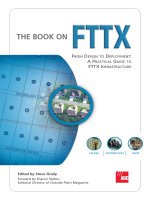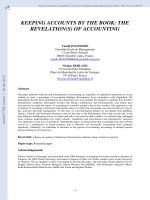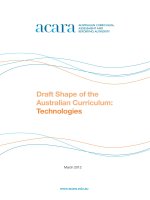Book The Grid Core Technologies
Bạn đang xem bản rút gọn của tài liệu. Xem và tải ngay bản đầy đủ của tài liệu tại đây (7.49 MB, 452 trang )
TEAM LinG
The Grid
The Grid
Core Technologies
Maozhen Li
Brunel University, UK
Mark Baker
University of Portsmouth, UK
Copyright © 2005 John Wiley & Sons Ltd, The Atrium, Southern Gate, Chichester,
West Sussex PO19 8SQ, England
Telephone (+44) 1243 779777
Email (for orders and customer service enquiries):
Visit our Home Page on www.wiley.com
All Rights Reserved. No part of this publication may be reproduced, stored in a retrieval system or
transmitted in any form or by any means, electronic, mechanical, photocopying, recording, scanning or
otherwise, except under the terms of the Copyright, Designs and Patents Act 1988 or under the terms of
a licence issued by the Copyright Licensing Agency Ltd, 90 Tottenham Court Road, London W1T 4LP,
UK, without the permission in writing of the Publisher. Requests to the Publisher should be addressed
to the Permissions Department, John Wiley & Sons Ltd, The Atrium, Southern Gate, Chichester,
West Sussex PO19 8SQ, England, or emailed to , or faxed to +44 1243 770620.
Designations used by companies to distinguish their products are often claimed as trademarks.
All brand names and product names used in this book are trade names, service marks, trademarks or
registered trademarks of their respective owners. The Publisher is not associated with any product or
vendor mentioned in this book.
This publication is designed to provide accurate and authoritative information in regard to the subject
matter covered. It is sold on the understanding that the Publisher is not engaged in rendering
professional services. If professional advice or other expert assistance is required, the services of a
competent professional should be sought.
Other Wiley Editorial Offices
John Wiley & Sons Inc., 111 River Street, Hoboken, NJ 07030, USA
Jossey-Bass, 989 Market Street, San Francisco, CA 94103-1741, USA
Wiley-VCH Verlag GmbH, Boschstr. 12, D-69469 Weinheim, Germany
John Wiley & Sons Australia Ltd, 33 Park Road, Milton, Queensland 4064, Australia
John Wiley & Sons (Asia) Pte Ltd, 2 Clementi Loop #02-01, Jin Xing Distripark, Singapore 129809
John Wiley & Sons Canada Ltd, 22 Worcester Road, Etobicoke, Ontario, Canada M9W 1L1
Wiley also publishes its books in a variety of electronic formats. Some content that appears in print
may not be available in electronic books.
Library of Congress Cataloging in Publication Data
Li, Maozhen.
Core technologies / Maozhen Li, Mark Baker.
p. cm.
ISBN-13 978-0-470-09417-4 (PB)
ISBN-10 0-470-09417-6 (PB)
1. Computational grids (Computer systems) 2. Electronic data processing—Distributed processing.
I. Baker, Mark. II. Title.
QA76.9.C58L5 2005
005.3
6—dc22
2005002378
British Library Cataloguing in Publication Data
A catalogue record for this book is available from the British Library
ISBN-13 978-0-470-09417-4 (PB)
ISBN-10 0-470-09417-6 (PB)
Typeset in 11/13pt Palatino by Integra Software Services Pvt. Ltd, Pondicherry, India
Printed and bound in Great Britain by Antony Rowe Ltd, Chippenham, Wiltshire
This book is printed on acid-free paper responsibly manufactured from sustainable forestry in which
at least two trees are planted for each one used for paper production.
Contents
About the Authors xiii
Preface xv
Acknowledgements xix
List of Abbreviations xxi
1 An Introduction to the Grid 1
1.1 Introduction 1
1.2 Characterization of the Grid 1
1.3 Grid-Related Standards Bodies 4
1.4 The Architecture of the Grid 5
1.5 References 6
Part One System Infrastructure 9
2 OGSA and WSRF 11
Learning Objectives 11
Chapter Outline 11
2.1 Introduction 12
2.2 Traditional Paradigms for Distributed Computing 13
2.2.1 Socket programming 14
2.2.2 RPC 15
2.2.3 Java RMI 16
2.2.4 DCOM 18
2.2.5 CORBA 19
2.2.6 A summary on Java RMI, DCOM and CORBA 20
2.3 Web Services 21
2.3.1 SOAP 23
2.3.2 WSDL 24
2.3.3 UDDI 26
2.3.4 WS-Inspection 27
2.3.5 WS-Inspection and UDDI 28
2.3.6 Web services implementations 29
2.3.7 How Web services benefit the Grid 33
vi CONTENTS
2.4 OGSA 34
2.4.1 Service instance semantics 35
2.4.2 Service data semantics 37
2.4.3 OGSA portTypes 38
2.4.4 A further discussion on OGSA 40
2.5 The Globus Toolkit 3 (GT3) 40
2.5.1 Host environment 41
2.5.2 Web services engine 42
2.5.3 Grid services container 42
2.5.4 GT3 core services 43
2.5.5 GT3 base services 44
2.5.6 The GT3 programming model 50
2.6 OGSA-DAI 53
2.6.1 OGSA-DAI portTypes 54
2.6.2 OGSA-DAI functionality 56
2.6.3 Services interaction in the OGSA-DAI 58
2.6.4 OGSA-DAI and DAIS 59
2.7 WSRF 60
2.7.1 An introduction to WSRF 60
2.7.2 WSRF and OGSI/GT3 66
2.7.3 WSRF and OGSA 69
2.7.4 A summary of WSRF 70
2.8 Chapter Summary 70
2.9 Further Reading and Testing 72
2.10 Key Points 72
2.11 References 73
3 The Semantic Grid and Autonomic Computing 77
Learning Outcomes 77
Chapter Outline 77
3.1 Introduction 78
3.2 Metadata and Ontology in the Semantic Web 79
3.2.1 RDF 81
3.2.2 Ontology languages 83
3.2.3 Ontology editors 87
3.2.4 A summary of Web ontology languages 88
3.3 Semantic Web Services 88
3.3.1 DAML-S 89
3.3.2 OWL-S 90
3.4 A Layered Structure of the Semantic Grid 91
3.5 Semantic Grid Activities 92
3.5.1 Ontology-based Grid resource matching 93
3.5.2 Semantic workflow registration and discovery in myGrid 94
3.5.3 Semantic workflow enactment in Geodise 95
3.5.4 Semantic service annotation and adaptation in ICENI 98
3.5.5 PortalLab – A Semantic Grid portal toolkit 99
3.5.6 Data provenance on the Grid 106
3.5.7 A summary on the Semantic Grid 107
CONTENTS vii
3.6 Autonomic Computing 108
3.6.1 What is autonomic computing? 108
3.6.2 Features of autonomic computing systems 109
3.6.3 Autonomic computing projects 110
3.6.4 A vision of autonomic Grid services 113
3.7 Chapter Summary 114
3.8 Further Reading and Testing 115
3.9 Key Points 116
3.10 References 116
Part Two Basic Services 121
4 Grid Security 123
4.1 Introduction 123
4.2 A Brief Security Primer 124
4.3 Cryptography 127
4.3.1 Introduction 127
4.3.2 Symmetric cryptosystems 128
4.3.3 Asymmetric cryptosystems 129
4.3.4 Digital signatures 130
4.3.5 Public-key certificate 130
4.3.6 Certification Authority (CA) 132
4.3.7 Firewalls 133
4.4 Grid Security 134
4.4.1 The Grid Security Infrastructure (GSI) 134
4.4.2 Authorization modes in GSI 136
4.5 Putting it all Together 140
4.5.1 Getting an e-Science certificate 140
4.5.2 Managing credentials in Globus 146
4.5.3 Generate a client proxy 148
4.5.4 Firewall traversal 148
4.6 Possible Vulnerabilities 149
4.6.1 Authentication 149
4.6.2 Proxies 149
4.6.3 Authorization 150
4.7 Summary 151
4.8 Acknowledgements 151
4.9 Further Reading 151
4.10 References 152
5 Grid Monitoring 153
5.1 Introduction 153
5.2 Grid Monitoring Architecture (GMA) 154
5.2.1 Consumer 155
5.2.2 The Directory Service 156
5.2.3 Producers 157
5.2.4 Monitoring data 159
viii CONTENTS
5.3 Review Criteria 161
5.3.1 Scalable wide-area monitoring 161
5.3.2 Resource monitoring 161
5.3.3 Cross-API monitoring 161
5.3.4 Homogeneous data presentation 162
5.3.5 Information searching 162
5.3.6 Run-time extensibility 162
5.3.7 Filtering/fusing of data 163
5.3.8 Open and standard protocols 163
5.3.9 Security 163
5.3.10 Software availability and dependencies 163
5.3.11 Projects that are active and supported;
plus licensing 163
5.4 An Overview of Grid Monitoring Systems 164
5.4.1 Autopilot 164
5.4.2 Control and Observation in Distributed
Environments (CODE) 168
5.4.3 GridICE 172
5.4.4 Grid Portals Information Repository (GPIR) 176
5.4.5 GridRM 180
5.4.6 Hawkeye 185
5.4.7 Java Agents for Monitoring and Management (JAMM) 189
5.4.8 MapCenter 192
5.4.9 Monitoring and Discovery Service (MDS3) 196
5.4.10 Mercury 201
5.4.11 Network Weather Service 205
5.4.12 The Relational Grid Monitoring
Architecture (R-GMA) 209
5.4.13 visPerf 214
5.5 Other Monitoring Systems 217
5.5.1 Ganglia 217
5.5.2 GridMon 219
5.5.3 GRM/PROVE 220
5.5.4 Nagios 221
5.5.5 NetLogger 222
5.5.6 SCALEA-G 223
5.6 Summary 225
5.6.1 Resource categories 225
5.6.2 Native agents 225
5.6.3 Architecture 226
5.6.4 Interoperability 226
5.6.5 Homogeneous data presentation 226
5.6.6 Intrusiveness of monitoring 227
5.6.7 Information searching and retrieval 231
5.7 Chapter Summary 233
5.8 Further Reading and Testing 236
5.9 Key Points 236
5.10 References 236
CONTENTS ix
Part Three Job Management and User Interaction 241
6 Grid Scheduling and Resource Management 243
Learning Objectives 243
Chapter Outline 243
6.1 Introduction 244
6.2 Scheduling Paradigms 245
6.2.1 Centralized scheduling 245
6.2.2 Distributed scheduling 246
6.2.3 Hierarchical scheduling 248
6.3 How Scheduling Works 248
6.3.1 Resource discovery 248
6.3.2 Resource selection 251
6.3.3 Schedule generation 251
6.3.4 Job execution 254
6.4 A Review of Condor, SGE, PBS and LSF 254
6.4.1 Condor 254
6.4.2 Sun Grid Engine 269
6.4.3 The Portable Batch System (PBS) 274
6.4.4 LSF 279
6.4.5 A comparison of Condor, SGE, PBS and LSF 288
6.5 Grid Scheduling with QoS 290
6.5.1 AppLeS 291
6.5.2 Scheduling in GrADS 293
6.5.3 Nimrod/G 293
6.5.4 Rescheduling 295
6.5.5 Scheduling with heuristics 296
6.6 Chapter Summary 297
6.7 Further Reading and Testing 298
6.8 Key Points 298
6.9 References 299
7 Workflow Management for the Grid 301
Learning Outcomes 301
Chapter Outline 301
7.1 Introduction 302
7.2 The Workflow Management Coalition 303
7.2.1 The workflow enactment service 305
7.2.2 The workflow engine 306
7.2.3 WfMC interfaces 308
7.2.4 Other components in the WfMC reference model 309
7.2.5 A summary of WfMC reference model 310
7.3 Web Services-Oriented Flow Languages 310
7.3.1 XLANG 311
7.3.2 Web services flow language 311
7.3.3 WSCI 313
7.3.4 BPEL4WS 315
7.3.5 BPML 317
7.3.6 A summary of Web services flow languages 318
x CONTENTS
7.4 Grid Services-Oriented Flow Languages 318
7.4.1 GSFL 318
7.4.2 SWFL 321
7.4.3 GWEL 321
7.4.4 GALE 322
7.4.5 A summary of Grid services flow languages 323
7.5 Workflow Management for the Grid 323
7.5.1 Grid workflow management projects 323
7.5.2 A summary of Grid workflow management 329
7.6 Chapter Summary 330
7.7 Further Reading and Testing 331
7.8 Key Points 332
7.9 References 332
8 Grid Portals 335
Learning Outcomes 335
Chapter Outline 335
8.1 Introduction 336
8.2 First-Generation Grid Portals 337
8.2.1 A three-tiered architecture 337
8.2.2 Grid portal services 338
8.2.3 First-generation Grid portal implementations 339
8.2.4 First-generation Grid portal toolkits 341
8.2.5 A summary of the four portal tools 348
8.2.6 A summary of first-generation Grid portals 349
8.3 Second-Generation Grid Portals 350
8.3.1 An introduction to portlets 350
8.3.2 Portlet specifications 355
8.3.3 Portal frameworks supporting portlets 357
8.3.4 A Comparison of Jetspeed, WebSphere Portal
and GridSphere 368
8.3.5 The development of Grid portals with portlets 369
8.3.6 A summary on second-generation Grid portals 371
8.4 Chapter Summary 372
8.5 Further Reading and Testing 373
8.6 Key Points 373
8.7 References 374
Part Four Applications 377
9 Grid Applications – Case Studies 379
Learning Objectives 379
Chapter Outline 379
9.1 Introduction 380
9.2 GT3 Use Cases 380
9.2.1 GT3 in broadcasting 381
9.2.2 GT3 in software reuse 382
9.2.3 A GT3 bioinformatics application 387
CONTENTS xi
9.3 OGSA-DAI Use Cases 387
9.3.1 eDiaMoND 387
9.3.2 ODD-Genes 388
9.4 Resource Management Case Studies 388
9.4.1 The UCL Condor pool 388
9.4.2 SGE use cases 389
9.5 Grid Portal Use Cases 390
9.5.1 Chiron 390
9.5.2 GENIUS 390
9.6 Workflow Management – Discovery Net Use Cases 391
9.6.1 Genome annotation 391
9.6.2 SARS virus evolution analysis 391
9.6.3 Urban air pollution monitoring 392
9.6.4 Geo-hazard modelling 394
9.7 Semantic Grid – myGrid Use Case 394
9.8 Autonomic Computing – AutoMate Use Case 395
9.9 Conclusions 397
9.10 References 398
Glossary 401
Index 419
About the Authors
Dr Maozhen Li is currently Lecturer in Electronics and Computer
Engineering, in the School of Engineering and Design at Brunel
University, UK. From January 1999 to January 2002, he was
Research Associate in the Department of Computer Science,
Cardiff University, UK. Dr Li received his PhD degree in 1997, from
the Institute of Software, Chinese Academy of Sciences, Beijing,
China. His research interests are in the areas of Grid computing,
problem-solving environments for large-scale simulations, soft-
ware agents for semantic information retrieval, multi-modal user
interface design and computer support for cooperative work. Since
1997, Dr Li has published 30 research papers in prestigious inter-
national journals and conferences.
Dr Mark Baker is a hardworking Reader in Distributed Systems
at the University of Portsmouth. He also currently holds visiting
chairs at the universities of Reading and Westminster. Mark has
resided in the relative safety of academia since leaving the British
Merchant, where he was a navigating officer, in the early 1980s.
Mark has held posts at various universities, including Cardiff,
Edinburgh and Syracuse. He has a number of geek-like inter-
ests, which his research group at Portsmouth help him pursue.
These include wide-area resource monitoring, messaging systems
for parallel and wide-area applications, middleware such as infor-
mation and security services, as well as performance evaluation
and modelling of computer systems.
Mark’s non-academic interests include squash (getting too old),
DIY (he may one day finish his house off), reading (far too many
science fiction books), keeping the garden ship-shape and a beer
or two to reduce the pain of the aforementioned activities.
Preface
Grid technologies and the associated applications are currently of
unprecedented interest and importance to a variety of commu-
nities. This book aims to outline and describe all of the compo-
nents that are currently needed to create a Grid infrastructure that
can support a range of wide-area distributed applications. In this
book we take a pragmatic approach to presenting the material;
we attempt not only to describe a particular component, but also
to give practical examples of how that software may be used in
context. We also intend to ensure that the companion Web site
has extensive material that can be used by not only novices, but
experienced practitioners too, to learn or gather technical material
that can help in the process of understanding and using various
Grid components and tools.
PURPOSE AND READERSHIP
The purpose of this book is not to convince the reader that one
framework, technology or specification is better than another;
rather its purpose is to expose the reader to a wide variety of what
we call core technologies so that they can determine which is best
for their own use.
This book is intended for postgraduate students and researchers
from various fields who are interested in learning about the core
technologies that make up the Grid today. The material being
developed for the companion Web site will supplement the book’s
content. We intend that the book, along with Web content, will
provide sufficient material to allow a complete self-study course
of all the components addressed.
The book takes a bottom-up approach, addressing lower-level
components first, then mid-level frameworks and systems, and then
finally higher-level concepts, concluding by outlining a number of
xvi PREFACE
representative Grid applications that provide examples of how the
aforementioned frameworks and components are used in practice.
We cover the core technologies currently in Grid environments
to a sufficient depth that readers will be prepared to take on
research papers and other related literature. In fact, there is often
sufficient depth that a reader may use the book as a reference of
how to get started with a particular Grid component.
The subject material should be accessible to postgraduates and
researchers who have a limited knowledge about the Grid, but
technically have some knowledge about distributed systems, and
experience in programming with C or Java.
2. OGSA and WSRF
3. The Semantic Grid and Autonomic Computing
4. Grid Security
5. Grid Monitoring
6. Grid Scheduling and Resource Management
7. Workflow Management for the Grid
8. Grid Portals
9. Grid Applications – Case Studies
System
Infrastructure
Basic Services
Job Management and
User Interaction
Applications
Figure P.1 Organization of the book
PREFACE xvii
ORGANIZATION OF THE BOOK
The organization of the book is shown in Figure P.P.1. We have
organized the book into four general parts, which reflect the
bottom-up view that we use to address the topics covered. We
know that certain topics have been discussed under different parts,
but we feel that this should assist the reader label topics more
easily and hopefully help them get to grips with the content more
easily.
The first section, “system infrastructure”, contains the chap-
ters that discuss and outline the current architecture, services and
instantiations of the Grid. These chapters provide the underpin-
ning information that the proceeding chapters build on. The sec-
ond section, “basic services”, contains the chapters that describe
Grid security and monitoring. Both these chapters explain services
that do not actually need to exist to have a Grid environment, but
without security and monitoring services it is impossible to have a
secure, robust and reliable environment that can be used by higher-
level services and applications. The third section we have labelled
“Job management and User interaction”. At this level users have
potentially direct access to tools and utilities that can change their
working environment (in the case of a Portal), or manage and
schedule their jobs (in the case of workflow and scheduling sys-
tems). Finally, the last section of the book is called “Applications”;
here we discuss a number of representative Grid-based applica-
tions that highlight the technologies and components discussed in
the earlier chapters of the book.
Acknowledgements
This first edition of our textbook was prepared during mid–late
2004, when the Grid-based technologies were not only at an embry-
onic stage, but also in a great state of flux. With any effort, such as
writing a book, nothing would really be accomplished in a timely
fashion without the aid of a large number of willing helpers and
volunteers. The technology landscape that we have been writing
about is changing rapidly, so we sought and asked experts in var-
ious fields to read through and comment on all parts of the book.
We would like to thank the following people for reviewing parts
of the book:
•
Chapter 2 – OGSA and WSRF: Stephen Pickles and Mark
McKeown (Manchester Computing, University of Manchester)
and Helen Xiang (DSG, University of Portsmouth).
•
Chapter 3 – The Semantic Grid and Autonomic Computing:
Rich Boaks (DSG, University of Portsmouth) and Manish
Parashar (Rutgers, The State University of New Jersey, USA).
•
Chapter 4 – Grid Security: Alistair Mills (Grid Deployment
Group, CERN).
•
Chapter 5 – Grid Monitoring: A special thank you to Garry Smith
(DSG, University of Portsmouth), who provided a lot of detailed
content for this chapter, and still managed to write and submit
his PhD.
•
Chapter 6 – Grid Scheduling and Resource Management:
NG1 – Fritz Ferstl (Sun Microsystems), Condor – Todd Tannen-
baum (Condor project, University of Wisconsin, USA), LSF –
Songnian Zhou (Platform Computing Inc, Canada), PBS – Bob
Henderson (Altair Grid Technologies, USA).
•
Chapter 7 – Workflow Management for the Grid: Omer Rana
(Cardiff University).
xx ACKNOWLEDGEMENTS
•
Chapter 8 – Grid Portals: Rob Allan (Daresbury Laboratory).
•
Chapter 9 – Grid Applications – Case Studies: Rob Allan (Dares-
bury Laboratory).
We like to make a special mention of and an acknowledge-
ment to Rob Allan (Daresbury Laboratory, UK), who meticulously
reviewed the book as a whole and fed back many useful comments
about its presentation and content.
We would like to say a special thanks to Birgit Gruber, our Wiley
editor, who worked closely with us through the production of the
book, and generally made the effort involved a pleasant one.
COMPANION WEB SITE
We have set up a Web site (coregridtechnologies.org) containing
companion material to the book that will assist readers and teach-
ers. The amount of content will grow with time and eventually
include:
•
Tables and figures from the book in various formats
•
Slides of the content
•
Notes highlighting various aspects of the content
•
Links and references to companion material
•
Laboratory exercises and solutions
•
Source code for examples
•
Potential audio/visual material.
Obviously, from the inception of book to its publication and distri-
bution, the landscape that we describe will have undulated some
more, so the book is a snapshot of the technologies during mid–
late 2004. We believe that we can overcome some of the gaps
that may appear in the book’s coverage of material by adding the
appropriate content to the companion Web site.
List of Abbreviations
Abbreviation Expanded form Context
ACL Access Control List
AM Actuator Manager CODE
AMUSE Autonomic Management of
Ubiquitous Systems for
e-Health
AppLeS Application Level Scheduler
APST AppLeS Parameter Sweep
Template
AppLeS
ASA Autonomic Storage
Architecture
ASAP Asynchronous Service Access
Protocol
ASP Active Server Pages Microsoft .Net
BLAST Basic Local Alignment Search
Tool
BPEL4WS Business Process Execution
Language for Web Services
BPML Business Process Modelling
Language
CA Certification Authority
CCA Common Component
Architecture
CFD Computational Fluid Dynamics
CGI Common Gateway Interface
CIM Common Information Model
ClassAd Classified Advertisement Condor
CMS Compact Muon Solenoid
COD Computing On Demand Condor
CODE Control and Observation in
Distributed Environments
xxii LIST OF ABBREVIATIONS
CORBA Common Object Request Broker
Architecture
OMG
CPS Certificate Policy Statement
CSF Community Scheduler
Framework
CSR Certificate Signing Request
DA Data Analyser GridICE
DAG Directed Acyclic Graph Condor
DAGMan Directed Acyclic Graph Manager Condor
DAIS Database Access and Integration
Services
DAISGR DAI Service Group Registry OGSA-DAI
DAML DARPA Agent Markup Language
DAML-S DAML Services DAML
DCE Distributed Computing
Environment
DCOM Distributed Component Object
Model
Microsoft
DCS Data Collector Service GridICE
DES Data Encryption Standard
DL Description Logic
DMTF Distributed Management Task
Force
DNS Detection and Notification
Service
GridICE
DPML Discovery Process Markup
Language
Discovery
Net
DSP Distributed Systems Group GridRM
DTD Document Type Definition W3C
EC Event Consumer JAMM
ECS Element Construction Set
EDG European Data Grid
EDSO Engineering Design Search and
Optimization
Geodise
EG Event Gateway JAMM
EGEE Enabling Grids for E-science in
Europe
EJB Enterprise JavaBeans J2EE
FaCT Fast Classification of
Terminologies
FIFO First In First Out
LIST OF ABBREVIATIONS xxiii
GA Genetic Algorithm
GAC GPIR Admin Client GPIR
GALE Grid Access Language
for high-performance
computing Environments
GAR Grid Archive GT3
GARA GARA
GDS Grid Data Service OGSA-DAI
GDSF Grid Data Service Factory OGSA-DAI
GDS-Perform Grid Data Service Perform OGSA-DAI
GDS-Response Grid Data Service Response OGSA-DAI
GEMLCA Grid Execution Management
for Legacy Code
Architecture
Geodise Grid Enabled Optimization
and DesIgn Search for
Engineering
GGF Global Grid Forum
GIP GPIR Information Provider GPIR
GIS Grid Information Services
GMA Grid Monitoring Architecture GGF
GPDK Grid Portal Development Kit
GPIR Grid Portals Information
Repository
GRAAP-WG Grid Resource Allocation
Agreement Protocol
Working Group
GrADS Grid Application Development
Software
GRAM Globus Resource Allocation
Manager
Globus
GridFTP Grid File Transfer Protocol Globus
GRIM Grid Resource Identity Mapper GT3
GSA Grid System Agent PortalLab
GSFL Grid Services Flow Language
GSH Grid Service Handle OGSA
GSI Grid Security Infrastructure Globus
GSR Grid Service Reference OGSA
GSSAPI Generic Security Services
Application Programming
Interface
GSSAPI
xxiv LIST OF ABBREVIATIONS
GT2 Globus Toolkit 2 Globus
GT3 Globus Toolkit 3 Globus
GT4 Globus Toolkit 4 Globus
GUSTO Generic Ultraviolet Sensors
Technologies and
Observations
GWEL Grid Workflow Execution
Language
GWSDL Grid WSDL GT3
HAT Heterogeneous Application
Template
AppLeS
HM Hawkeye Manager Condor
HMA Hawkeye Monitoring Agent Condor
HPSS High-Performance Storage
System
ICENI Imperial College e-Science
Networked Infrastructure
ICENI
IDL Interface Definition Language
IPG Information Power Grid
IIOP Internet-Inter ORB Protocol CORBA
ISAPI Internet Server Application
Programming Interface
Microsoft .Net
J2EE Java 2 Enterprise Edition
J2SE Java 2 Standard Edition
JAMM Java Agents for Monitoring
and Management
JAR Java Archive Java
Java CoG Java Commodity Grid
JAXB Java Architecture for XML
Binding
J2EE
JAXM Java API for XML Messaging J2EE
JAXP Java API for XML Processing J2EE
JAXR Java API for XML Registries J2EE
JAX-RPC Java API for XML-Based RPC J2EE
JCE Java Cryptography Extension
JCP Java Community Process
JCR Java Certificate Request
JNDI Java Native Directory Interface
JISGA Jini-based Service-Oriented
Grid Architecture
JRE Java Run time Environment









